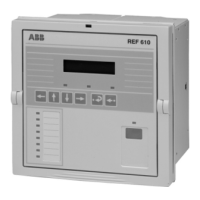current rises from a value below 0.12 x I
0
> to a value above 1.5 x I
0
> within less
than 60 ms. The start situation ends when the current falls below 1.25 x I
0
> and
remain below for at least 200 ms. The selection is made in SGF4.
Consider carefully when using the automatically doubled setting for
the set start value of stage I
0
>>.
Stage I
0
>> can be set out of operation in SGF3. This state will be indicated by
dashes on the LCD and by “999” when the set start value is read via serial
communication. It is possible to block the tripping of an earth-fault stage by
applying a digital input signal to the relay.
Stages I
0
> and I
0
>> can be set to be blocked by the auto-reclose
function.
5.1.4.4. Thermal protection for cables
The thermal protection detects long-time overloads during normal operation.
Prolonged overloading results in the thermal stress capacity of the cable being
exceeded, which degrades the insulation of the cable, which in turn may cause a
short circuit or an earth fault. The heating up of the cable follows an exponential
curve, the levelled-out value of which is determined by the squared value of the load
current. The thermal protection may equally well be used to protect dry-type
transformers, capacitor banks, busbars and overhead lines, for instance.
The thermal protection stage continuously calculates the thermal capacity used as a
percentage of the cable’s total thermal capacity. The thermal capacity is calculated
as follows:
θ
θ
τ
=
I
1.05 I×
×
⎛
⎟
−
()
×
−
2
1 100e
t /
%
(1)
θ = thermal capacity
I = phase current value
I
θ
= set full load current
t = time (in minutes)
τ = time constant (in minutes)
When one or several phase currents exceed the set full load current, I
θ
, stage θ> will
start. At the same time, the thermal capacity will start to increase at a rate depending
on the current amplitude and the prior load of the cable.
When the thermal capacity, influenced by the thermal history of the cable, exceeds
the set alarm level, θ
a
>, the stage will generate an alarm signal. The thermal alarm
can be used to avoid unnecessary tripping due to a beginning overload. The thermal
level at various constant currents are presented in the table below:
28
REF 610REF 610
Feeder Protection Relay
Technical Reference Manual
1MRS755310

